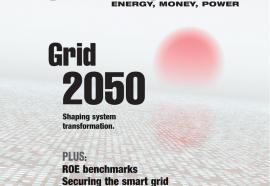Commission
Cap-Ex Conundrum
Does slow and steady still win the race?
When a capital-intensive industry enters an asset-building cycle, many companies will operate in the red for a few years or more. That’s not necessarily a bad thing, as cap-ex investments represent growth for shareholders. The devil is in the details, however, and companies facing a large slug of environmental compliance investments might produce disappointing returns over the next few years.
Vendor Neutral
(September 2011) Walgreens to install eVgo charging stations at 800 sites; Siemens and eMeter team up in Maryland; Glasgow muni installs Elster meters; ABB completes Mincom acquisition; JDSU acquires Quanta-Sol PV technology; Survalent installs SCADA system at tidal power project; PECO selects Telvent; plus announcements and contracts involving Trilliant, Sensus, S&C Electric, Navigant, Ernst & Young, PSE&G, Portland General Electric and others.
Bonneville's Balancing Act
In the Pacific Northwest, you either spill water or spill wind.
The wind power industry has been up in arms ever since the Bonneville Power Administration earlier this year announced its Interim Environmental Redispatch and Negative Pricing Policy. That policy, applicable during periods of high spring runoff and heavy water flow volumes on the Federal Columbia River Power System, calls for BPA to redispatch and curtail access to transmission for wind power generating turbines, and to replace that resource with hydroelectric power generated via BOA hydroelectric dams, in order to avoid having to divert water through dam spillways, which could threaten fish and wildlife by creating excess levels of Total Dissolved Gas (TDG), which can cause Gas Bubble Trauma. Yet the legal issue remains unclear: Does this practice imply discrimination in the provision of transmission service, or is it simply a matter of system balancing and generation dispatch? In fact, the FERC may lack jurisdiction over the dispute, as it pertains to the fulfillment of BPA’s statutory mandates.
Gas Demand Response
Submitted by meacott on Thu, 2011-08-25 18:03In general, demand response refers to the ability of consumers to respond to a supply shortage by curtailing demand, thereby improving economic efficiency. Since the California energy crisis, demand response has been widely used in electricity markets throughout the United States and Canada.1 Recent developments in the natural gas sector suggest that the time may have come to also introduce demand response in that sector.
EVs and the Smart Grid
Submitted by meacott on Thu, 2011-08-04 18:03A century or so ago, Thomas Edison’s commercialization of electricity unleashed an unprecedented cascade of change, altering the way humanity worked, lived and interacted. Today, with the convergent rise of the smart grid, renewable energy and electric vehicles (EVs), the power sector is embarking on a second era of transformation that promises to deliver a smarter, greener and more efficient 21st century.
People (August 2011)
Vendor Neutral
(August 2011) Shaw Group completes 500 MW combined cycle plant; Pattern Energy begins building Spring Valley wind farm; AEP, Duke and TVA team up on interstate transmission line; AEP and MidAmerican contract for Texas transmission projects; Alliant contracts Open Systems International for volt-VAR control system; Alstom buys into AWS Ocean Energy; Siemens acquires shares in PV manufacturer Semprius; Lockheed Martin introduces cyber security system; plus contracts and announcements involving Elster, Itron, Suzlon, Solon, Sensus, Westinghouse Electric, Morgan Lewis and others.
Better Safe Than Compliant
Protecting the smart grid requires a broader strategy.
NERC’s critical infrastructure protection (CIP) standards set a minimum level of security performance—and only for high-voltage transmission systems, not the distribution grid. A compliance-checklist approach to security might lack the adaptability needed to combat evolving threats like the Stuxnet worm. A multi-layered, risk-based approach will provide better protection for the emerging smart grid.
Planning for Efficiency
Forecasting the geographic distribution of demand reductions. Copyright © 2011 Consolidated Edison Company of New York, Inc.
As new energy efficiency programs proliferate, regulators increasingly will seek to use the associated demand reductions to reduce capital expenditures on new transmission and distribution assets. However, forecasting the expected geographic distribution of these demand reductions within the grid and integrating this information into a utility’s capital planning process is a challenging task.






